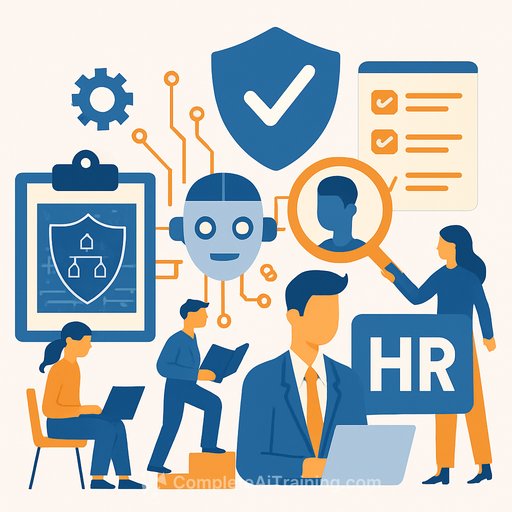AI & Employment: How HR Should Approach AI Governance Moving Forward
AI is now embedded in recruiting, performance, and employee service workflows. The opportunity is efficiency. The risk is bias, privacy exposure, and a hit to trust if things go wrong.
The fix is clear: build practical AI governance that protects people and keeps HR compliant while still moving fast. HR teams that act now will set the standard for fair, defensible, and effective people operations.
Why HR Must Lead on AI Governance
Left unchecked, AI systems can amplify bias in hiring, mishandle sensitive data, and leak intellectual property through careless use of generative tools. None of that is acceptable for a function built on fairness, compliance, and confidentiality.
We've seen documented issues: resume screeners that skew by gender or race, opaque performance insights that tilt decisions, and privacy gaps in tools that process personal information. HR owns the people consequences, so HR must set the guardrails.
The Regulatory Picture: Moving Targets, Clear Direction
State lawmakers introduced hundreds of AI-related bills in 2024 across most of the U.S. Many touch hiring and employment decisions. Public-sector rules in places like Kentucky and Texas already require governance frameworks-signals of what private employers may soon face.
Track the trend lines and get ahead of it. For a policy pulse check, see legislative trackers from trusted sources like the National Conference of State Legislatures (NCSL 2024 AI legislation).
Build on the NIST AI Risk Management Framework
You don't need to invent a model from scratch. The NIST AI Risk Management Framework (AI RMF) gives HR a practical baseline for trustworthy AI-flexible enough for small teams and enterprise programs.
Start here: NIST AI RMF.
Translate NIST into HR Action
- Govern: Create HR policies, approval workflows, and accountability. Name an HR AI governance lead. Set risk thresholds for different use cases. Require pre-purchase reviews for all AI features in HR tech.
- Map: Inventory every HR system with AI-ATS screeners, scheduling tools, chatbots, learning platforms, workforce analytics, performance insights. Note where it's used and who is affected.
- Measure: Test outcomes. Monitor bias by protected group. Audit decision quality, error rates, and legal compliance. Verify vendor claims with your own checks.
- Manage: Mitigate risks with human review, data controls, vendor requirements, and recurring audits. Train HR teams on correct usage and escalation paths.
HR's AI Reality: One Function, Many Risk Profiles
Recruiting needs bias controls and explainability for candidate screening and assessments. Employee relations needs tight privacy and accuracy for benefits chatbots and policy Q&A. Performance tools need transparency and fairness in ratings and promotion signals.
One policy won't cover it all. You need consistent standards across HR, plus playbooks that fit each function's risks and decisions.
The First Brick: Create Your HR AI Registry
A registry is your source of truth. It lists every AI use in HR, from "smart" features inside your HRIS to machine learning in analytics platforms. Most teams find more AI in their stack than expected-especially embedded features that slipped in with upgrades.
Capture this for each system:
- Business use (recruiting, onboarding, performance, learning, compensation, workforce planning)
- Data in scope (resumes, interviews, performance notes, comp data, benefits, demographics)
- Decision impact (advisory vs. automating a decision; human-in-the-loop details)
- Risk areas (bias, privacy, security, transparency, IP exposure)
- Access controls (roles, permissions, audit logs)
- Vendor details (model type if shared, training data sources, bias testing, SOC/ISO attestations)
This inventory lets you prioritize oversight, standardize tools, and cut spend on duplicate features.
Set Up HR AI Governance Oversight
Establish a dedicated role or committee in HR. In smaller orgs, embed it in people analytics or compliance. In larger orgs, stand up a cross-functional program with HR, Legal, IT, Security, and Privacy.
- Publish HR-wide AI policies and standards
- Review and approve new AI purchases and implementations
- Own training and change management for AI use in HR
- Share learnings across recruiting, ER, L&D, compensation, and analytics
- Coordinate with IT, Legal, and Compliance on data, contracts, and audits
- Monitor bias, accuracy, drift, and incidents; handle employee/candidate inquiries
Practical Steps HR Leaders Can Take This Quarter
- Run an AI inventory: Survey every HR platform and team workflow for AI features. Include chatbots, scoring, recommendations, summarization, and pattern detection.
- Triage by risk: Start with systems that influence employment decisions-screening, promotion, and performance. Add stricter controls and more frequent audits here.
- Write clear policies: Define approved tools, data input rules (no sensitive PII into public models), and required human oversight. Cover generative AI usage, prompts, and output review.
- Implement bias testing: Test outcomes by protected group on a set cadence. Document methods, thresholds, and remediation plans. Do not rely only on vendor attestations.
- Increase transparency: Tell candidates and employees where AI is used, what it influences, and how to request human review. Provide a clear contact for concerns.
- Train your team: Teach HR staff how the tools work, where they fail, and how to spot bias or hallucinations. Set standard operating procedures for overrides and escalation.
- Tighten vendor management: Update procurement checklists to include AI risk questions, data handling, model updates, bias audits, and incident reporting.
- Secure the data: Minimize sensitive inputs, enforce role-based access, enable logging, and set retention policies aligned with employment laws.
What "Good" Looks Like in HR AI Governance
Every AI use in HR is documented in the registry, owners are named, and reviews have a cadence. High-impact tools have human-in-the-loop controls and bias testing before and after deployment.
Employees and candidates know where AI is used and how to get a human review. Vendors meet your standards, and contracts reflect that. Incidents are logged, investigated, and fed back into continuous improvement.
The ROI: Trust, Compliance, and Better Outcomes
Governance is not bureaucracy-it is insurance for decision quality and brand trust. You reduce legal exposure, speed up audits, and improve candidate and employee experience by making decisions more consistent and explainable.
As AI gets smarter-from matching candidates to guiding development plans-your framework scales with it. The teams that get this right will recruit faster, evaluate more fairly, and support employees with less friction.
Next Steps
- Adopt the NIST AI RMF as your foundation and translate it into HR policies and playbooks.
- Stand up your registry and oversight function, then prioritize the highest-risk tools.
- Institutionalize testing, transparency, and training. Iterate every quarter.
If you want structured learning paths for HR teams building AI fluency and governance skills, explore role-based programs here: Complete AI Training - Courses by Job.
Your membership also unlocks:






